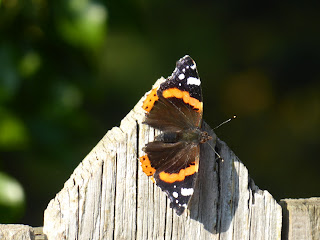It was apparent that there were a few scarcities turning up on the Northumberland coast in the recent mild weather, including snow bunting, taiga bean goose and hawfinch as well as winter visitors like brambling and waxwing.
Noting that there were some recent sightings near Alnmouth, we decided to give the shore lark a try. The first location we visited was Buston Links where we drew a blank after just seeing a few waders on the beach. It was also tricky to get to over a very stony bridle path that would really have been better tackled in a four by four. I'd have thought it was dangerous to horses. However the area to the south of Church Hill and behind the dunes had its strange charms - a sort of green lunar landscape around the channel cut out along the path of the River Aln in bygone days.
 |
| Stonechat |
I was going to head over the bridge but a couple of blokes turned up with a large telescope and headed down towards the shore on the South side. Thinking they were looking for the larks, I suggested we follow them. Eventually they set up the telescope and appeared to be scanning the mass of gulls at the estuary mouth for something more interesting. Not wishing to queer their patch we diverted to another green, mossy, oval-shaped area behind the dunes. Malcolm took the seaward side
with Arthur the retriever and I skirted the bank at the landward edge.
When we met at the end, Malcolm said that he had seen some brownish birds running around. We retraced the last few yards he had covered and they were still there. In the failing light it took a few squints through the binoculars to verify it as they scurried about but they were indeed the desired shore larks.
 |
| Shore larks |
Not a great rarity these days, but they only occur on the East coast and it was very pleasing to find them when we didn't have a precise idea where to look and were basically ambling around in hope with a dog. It was also the first time I've ever seen them.
We decide to leave the taiga bean goose for another day.















































